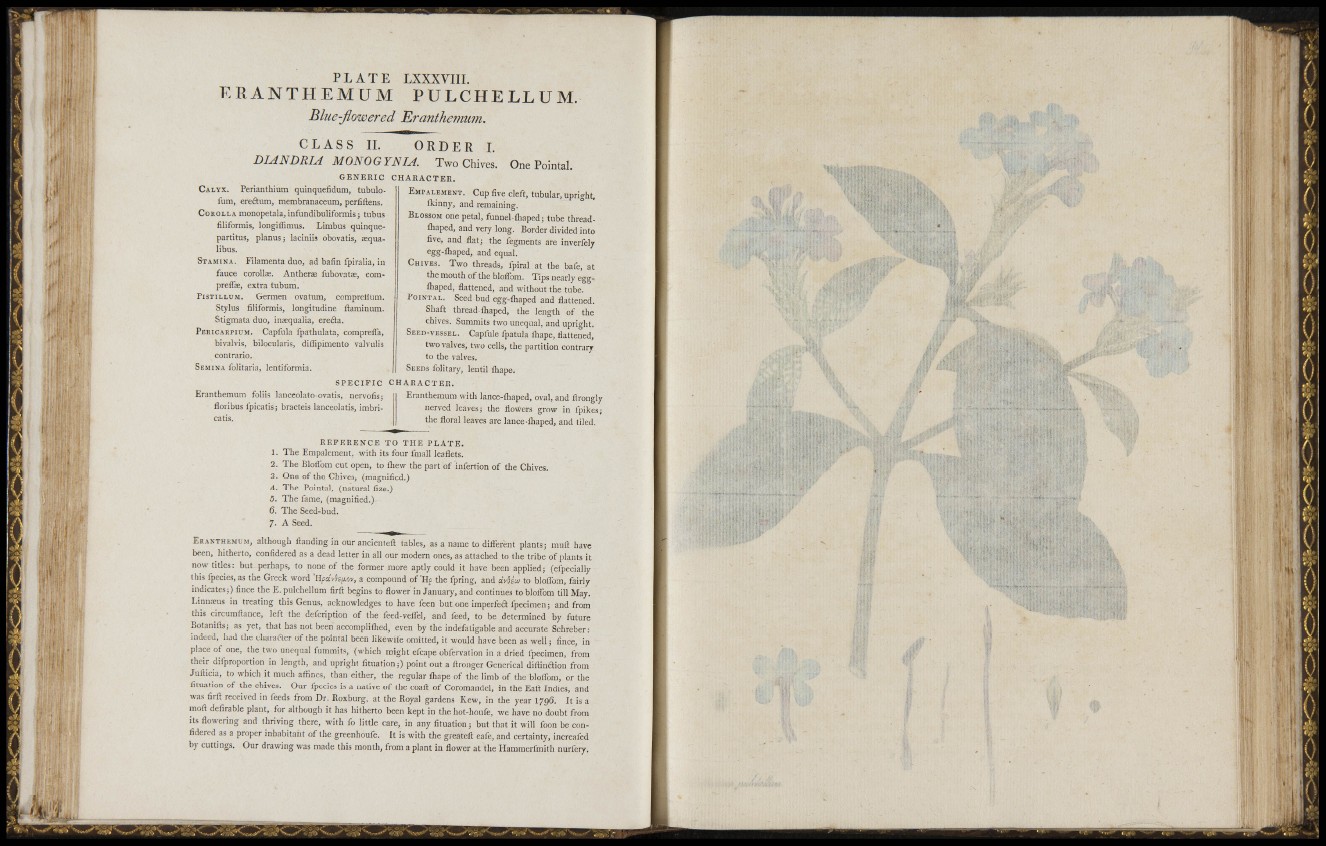
¡í
í l
i' i !«
i"
i? Jfci'sA
P L A T E LXXXYIII
E R A N T H E M U M PULCHELLUM.
Blue-Jlowered Eranthemum.
C L A S S IL ORDER L
DIANDRIA MONOGYNIA. Two Chives.
G E N E R I C CHAKACTEE.
One Pointai.
CALYX. Perianthium quinquefidum, tubulolum,
ereñum, membranaceum, perfiñens.
COROLLA monopetala, ¡nfundibul iformi s ; tubus
filiformis, longiffimus. Limbus quinquepartitus,
planus ; lacinüs obovatis, ¡equalibus.
STAMINA. Filamenta duo, ad bafin fpiralia, in
fauce corolla;. Antherae fubovatae, compreflae,
extra tubum.
PisTiLLUM. Germen ovatum, compreíTum.
Stylus filiformis, longitudine ftaminum.
Stigmata duo, inaequalia, ereüa.
PEKICAKPIUM. Capfula Ipathiilata, comprefla,
bivalvis, bilocularis, diflipimento valvulis
contrario.
SEMINA folitaria, lentiformia.
S P E C I F I C
Eranthemum foliis lanccolato-ovatis, nervofis;
floribus fpicatis; bracteis lanceolatis, imbrica
tis.
EMPALEMENT. Cup five cleft, tubular, upright,
Ikinny, and remaining.
BLOSSOM one petal, funnel-fliaped; tube threadihaped,
and very long. Border divided into
five, and flat; the fegments are inverfely
egg-fliaped, and equal.
CHIVES. TWO threads, fpiral at the bafe, at
the mout h of the bloflbm. Tips nearly eggihaped,
flattened, and without the tube.
PoiNTAL. Seed bud egg-lhaped and flattened.
Shaft thread fliaped, the length of the
chives. Summits two unequal, and upright.
SEED-VESSEL. Capfule fpatula lliape, flattened,
two valves, two cells, the partition contrat/
to the valves.
SEEDS folitary, lentil Ihape.
C H A I Î A C Ï E E .
Eranthemum with lance-ihaped, oval, and flrongly
nerved leaves; the flowers grow in fpikes;
the floral leaves are lance-Ihaped, and tiled.
R E F E R E N C E TO THE PLATE.
1. The Empalement, with its four fmall leaflets.
2. The Blolfom cut open, to ftiew the part of infertion of the Chives.
3. One of the Chives, (magnified.)
4 . The Pointal, (natural fize.)
5. The fame, (magnified.)
6. The Seed-bud.
7. A Seed.
EEANTHEMUM, although fl:anding in our ancienleft tables, as a name to different plants; muft have
been, hitherto, confidered as a dead letter in all our modern ones, as attached to the tribe of plants it
now titles: but perhaps, to none of the former more aptly could it have been applied; (eCpecially
this fpecies, as the Greek word 'HpavJifAov, a compound of'Hf die fpring, and d-Aiuj to bloflbm, fairly
indicates;) fince the E. pulchellum firft begins to flower in January, and continues to blolfom till May.
Linnaeus in treating this Genus, acknowledges to have feen but one imperfetT: fpecimen; and from
this circumftance, left the defcription of the feed-veifel, and feed, to be determined by future
Botanifts; as yet, that has not been accompliihed, even by the indefatigable and accurate Sclireber:
indeed, had the eharafter of the poinlal been likewife omitted, it would have been as wel l ; fince, in
place of one, the two unequal fummits, (which might efcape obfervalion in a dried fpecimen, from
their difproportion in length, and upright fituation;) point out a Itronger Generical dillinaion from
Jufticia , to which it much affincs, than either, the regular fliape of the limb of the blolfom, or the
fituation of the chives. Our fpecies is a native of the coaft of Coromandcl, in the Eaft Indies, and
was firit received in feeds from Dr. Roxburg, at the Royal gardens Kew, in the year 1796. It is a
moft defirable plant, for although it has hitherto been kept in the hot-houfe, we have no doubt from
its flowering and thriving there, with fo little care, in any fituation; but that it will foon be confidered
as a proper inhabitant of the greenhoufe. It is wi t h the greateft eafe, and certainty, increaled
by cuttings. Our drawing was made this month, from a p lant in flower at the Hammer fmi t h nurfery.
'hi
1'
• '1 ,
> I.
• I
i :
ri»
li
M'!
• f.i
h •
• i :